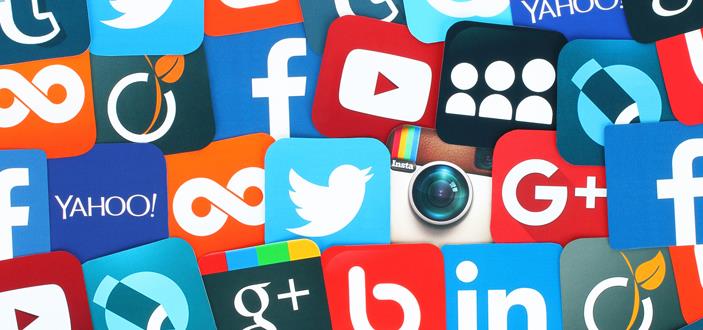Types Of Modern Communication
18 December, 2018 | Web design

Communication is key to building relationships, and modern forms of communication allows us to stay in touch with friends and family from anywhere in the world.
Today, modern technology dominates our communication. We have a massive range of ways in which we can stay connected, but each channel of communication can influence our relationships in a different way.
Here are 10 modern communication tools to help you stay in connect with your audience:
Social Media

Social media has been around since the early days of the internet and it still dominates most of our lives. The long list of social networks continues to grow and each one is continuing to drive millions (and even billions) of users to their sites everyday which is why it is one of the most popular forms of communication.
Social media may be all about brand awareness, but it is also a great channel for communication as it enables you to post open messages for everyone to see, as well as engage with users through comments.
Whatever you use it for, it’s a great first step for communication. Your messages aren’t limited to your followers either, through the power of hashtags, shares, likes, retweets, hearts and other reaction your posts have no limit to the audience it can reach. We’ve all witnessed the power of posts going viral.
Here are 16 social media stats you can’t ignore.
Social Media – Direct Message (DM)
Social media doesn’t necessarily need to be completely public. Almost every social media channel offers a direct messaging option, some of those messaging services even have their own messaging app such as Facebook Messenger.
Private messaging through social networks has the same intimacy as email but tends to be less formal.
Businesses should only contact someone through Direct Message if the customer has reached out to them through that channel. However, certain direct messaging techniques are becoming a little more acceptable on some social networks such as Facebook. Facebook Messenger Bots are now seen as the norm and can help you to connect with your audience through Facebooks messaging service.
Instant Message (IM)
While some forms on Instant Message falls under social media like Facebook Messenger, there are a wide range of Instant Messaging platforms that aren’t connected to social networks such as Google Hangouts and WhatsApp.
IM is a great tool for quick informal chats or group chats.
SMS Text Messaging
We are all aware of the uses of text messaging. They are short, generally informal and are a good way to communicate small bits of information that can be received and replied to at the recipient’s own leisure.
These days we are almost always within arm’s reach of a mobile device, so it isn’t a surprise that more people are using their smartphones more than computers to search, research and communicate than ever before, making it the perfect platform to engage with your audience.
Email Marketing

The first mass email was sent back in 1978 and even back then it was highly successful. However, today it is one of the most underestimated marketing platforms around, despite being one of the most beneficial in terms of return on investment.
Email marketing can be used for many different purposes, including to push products and services, spread news, raise brand awareness or to deliver a message to the masses.
Over the years, most businesses would have accumulated a great deal of email address and in many cases, they would go to waste. With email marketing those email addresses will enable you to reconnect with old clients as well as connect with new potential clients.
Direct Email
Email is similar to direct messaging through social networks, but it is generally more formal. It is the most popular way of communicating between businesses with over 200 billion emails being sent every day.
Blogging
A blog is a conversational styled website that enables you to publish messages, news, knowledge or any other kind of information on the world wide web for everyone to see.
Most blogs include a comments section in which you can engage with those likeminded people that are interested in your blog post. This is why it is a great platform for communication.
Voice Calling
Voice calling is even more personalised than the channels previously mentioned. The telephone or mobile phone instantly allows both parties to hear the tones and emotions of the other caller and is one of the most commonly used communication tools.
Video Chat

Video chat enables both parties to see each other, allowing you to be able to read body language and facial expressions. This form of communication isn’t as popular as the voice calling but it does have its advantages.
With several video-calling apps available for free such as Apple’s FaceTime, Facebook messenger, Skype and WhatsApp, video calls are definitely worth considering.
Video Marketing
Video has really taken off over the last few years with the help of social channels like YouTube, Facebook, Snapchat and Instagram. It also helps that it is easier than ever to record videos with smartphones and cameras always handily available.
It’s important that you get your message across in a variety of formats and video is one of the most popular ways in which you can do so as it significantly boosts engagement.
Live Web Chat

You are likely to have seen a lot of these on websites already and they can be very helpful if you are able to manage them correctly. Live web chats allow people on your website to ask you questions directly in real time without leaving your website.
You should only consider using live web chat if you can guarantee someone will always be actively using the widget. If it takes more than a few seconds to respond to someone via web chat it will reflect poorly on your business so it’s best to avoid these widgets if you can’t maintain the demand.
Here are the pros and cons of live web chat.
Virtual Reality
The video above shows us the potential virtual reality can have for communication. Facebook has been developing social VR for several years now and although it isn’t a common way of communication yet, it has a lot of potential.
As virtual reality advances and prices for the headsets fall, VR popularity will inevitably increase. With more and more people buying VR headsets this could be the next modern form of communication to hit the masses and it may only be a few years away.
Find Out More About Modern Communication Here






